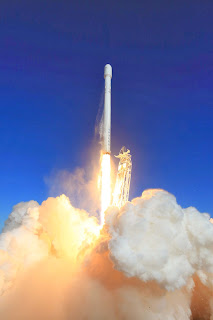SpaceX successfully launched its new 1.1 version of the Falcon 9 rocket yesterday under a beautiful blue California sky.
The 1.1 version of the rocket is longer (for more fuel) and features the new, more powerful, Merlin 1D engines. It also flew with a larger cargo faring that provides both more protection and more cargo volume. There are other minor differences in the 1.1 version as well, such as updated flight avionics, and the rearrangement of the booster's engines in a circular arrangement as opposed to the 3x3 grid of the previous rocket.
This is also the first launch from the new Vandenberg Air Force Base launch site. This is the site that should soon see the first test of the Falcon Heavy rocket. While I haven't heard much about the Falcon Heavy lately - its still on the launch manifest for 2014. Additionally, the Vandenberg site provided the chance to try a controlled decent of the booster - an important capability that the Grasshopper project is working towards. The first part of the controlled decent went well, but the second burn put the booster into a spin, so controlled decent didn't happen - but it really wasn't expected to. Since this launch provided an opportunity give it a try, an attempt couldn't be passed up, and I'm sure it yielded valuable data. The next two launches will not afford another attempt as they will require all of the rocket's available fuel to get its payloads into geosynchronous orbit. So, although SpaceX is still firmly committed to booster reusability, full flight testing will have to wait a while.
And those next launches will be another first for SpaceX, as all of its launches to date have been to LEO (low earth orbit). In case you aren't intimately familiar with the different Earth orbits, Low Earth Orbit (LEO) is generally between 160 kilometers (99 mi) and 2,000 kilometers (1,200 miles). Geosynchronous orbit however is approximately 35,786 km (22,236 mi) - nearly 20 times higher!
Additionally, after deploying the payload, an attempt to reignite the second stage Merlin 1D in order to demonstrate its ability to restart in space, was unsuccessful. During the restart the engine detected a problem and aborted the burn.
But the primary missions of demonstrating the Falcon 9 v1.1 rocket, and of placing its six payloads into stable orbit were complete successes. The primary payload was the Cascade Smallsat and Ionospheric Polar Explorer (CASSIOPE) satellite. The secondary payloads included the Polar Orbiting Passive Atmospheric Calibration Spheres (POPACS) CubeSat, the Drag & Atmospheric Neutral Density Explorer (DANDE) spherical spacecraft, and the CUSat technology demonstrator satellite.
Read more about these payloads, and all of the mission's details in the press kit, and be sure to check out these hi-res photos and videos.

No comments:
Post a Comment